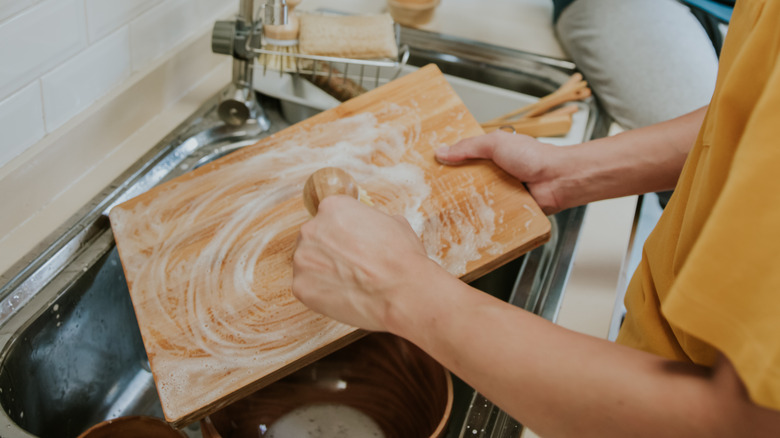The Type Of Wood Alton Brown Suggests For Your Cutting Board
Alton Brown wants you to ditch your cheap cutting board. The food personality and TV host, well known for his crafty kitchen hacks like wearing gloves to make salsa, is also quite opinionated when it comes to the perfect cutting board. Hard maple wood, Brown claims, is the ideal material for withstanding every day chopping, slicing, and dicing because of its durability and longevity. On his website, Brown explained, "Bamboo? I'm not a fan. Give me a maple board from the John Boos company every time."
In general, wooden boards are more environmentally-friendly, aesthetically pleasing, and cost effective than plastic boards that need to be replaced often. But the thickness and heft of maple in particular makes it an ideal material, as more lightweight boards are not as sturdy and can lead to knives slipping and sliding, which can cause accidents.
Cutting boards made with maple are also less harsh on your kitchen knives than other woods since the material allows the blades to glide along the surface with less resistance than a material like bamboo. And using a heavy hard maple board can extend the lifespan of your knives by reducing the need for constant honing and sharpening. Maple also has a finer grain and smaller pores, which prevents bacteria-causing food particles from embedding into the surface. It's also more scratch-resistant than its softwood counterparts, meaning that with routine cleaning and maintenance (without lemon), a maple cutting board can last in your kitchen for decades.
Caring for your maple cutting board
Since maple is a porous material, these kinds of cutting boards require special maintenance and care. The most important thing to remember is to never soak your board or put it in the dishwasher, as this can cause the wood to swell, warp, and crack irreparably. Cosmetic scratches, however, can easily be smoothed out with fine grit sandpaper rubbed along the wood grain. To clean your board, simply hand-wash it in warm, soapy water, making sure to also wash the unused side to prevent uneven rocking.
When drying, always store your cutting board vertically on a countertop or rack so that both sides can receive proper airflow. Boards that are stored flat in drawers or cupboards can draw in humidity from those environments, which leads to warping. Conditioning your maple cutting board once or twice a month is just as important as washing and will extend the life of the board for years. To do so, apply a thin layer of mineral oil or beeswax to the entire surface and allow it to soak into the wood fibers overnight.


